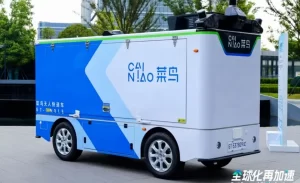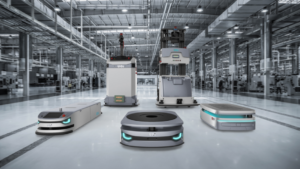Material Handling, Inspection, Construction Assistance, and More
In the wave of automation, robot technology is rapidly infiltrating various industries. While driving industry transformation and upgrades, it is also giving rise to new demands. In recent years, mobile robots have begun to make their mark in the construction industry, injecting new vitality into construction sites.
The imminent transformation of the construction industry towards intelligence
The construction industry is one of the largest sectors in the global economy, yet it has been among the slowest to undergo automation and digital transformation. Massive initial investments, complex implementation processes, high communication costs, and a lack of specific construction tools have collectively contributed to the delayed progress of automation in the construction sector.
However, with changes in the labor force structure, the impact of aging populations on labor-intensive industries like construction is gradually becoming evident. According to data from the National Bureau of Statistics in China, the number of construction workers has decreased by nearly 10 million in seven years. The proportion of construction workers aged 21 to 30 is decreasing each year, while the proportion of those aged 50 and above is increasing. This trend not only results in a shortage of labor in the construction industry but also an increased likelihood of workplace injuries due to the aging workforce. Consequently, there is an urgent need for a solution that can intervene in these hazardous tasks and address the labor shortage.
Against this backdrop, the application of robots on construction sites emerges as one of the solutions. The advantages of these robots are evident: they can significantly reduce labor costs and risks, enhance work efficiency and productivity, and achieve automation and intelligence on construction sites.
Although the development of automation technology in the construction industry has been relatively slow, the time is ripe for its significant role in the digital transformation of the sector. Through collaborative efforts from businesses, governments, and academia, autonomous mobile robots have been applied in various fields such as construction, bricklaying, demolition, and infrastructure, bringing limitless possibilities for the future of the construction industry.
Smart Evolution on Construction Sites: Five Major Application Scenarios for Mobile Robots
The Rapid Transformation of Traditional Construction: Five Key Application Scenarios for Mobile Robots on Construction Sites
Mobile robots are rapidly reshaping traditional construction methods when deployed on construction sites. Currently, there are five major application scenarios for mobile robots on construction sites:
1. Intelligent Material Handling and Delivery
Mobile robots can transport materials on construction sites, such as bricks, cement, and other building supplies, alleviating the burden on workers and improving efficiency. The Husky robot, developed by the Canadian company Clearpath Robotics, is widely used for logistics and transportation tasks on construction sites. It can carry heavy construction materials and equipment, autonomously navigating along predetermined paths without the need for human intervention throughout the entire process.

The Husky robot by Clearpath Robotics
In a recent project at the Lushan Laboratory of Hunan Construction Engineering Group, Xingshen Tech Unmanned Vehicles were employed to transport documents, materials, and tools on the construction site. Workers simply need to issue commands via their smartphones, and the unmanned vehicles will carry out deliveries along specified or intelligently planned routes, significantly enhancing the convenience of on-site operations.

Xingshen Tech Unmanned Vehicle
2. Intelligent Inspection
Robots can conduct regular safety inspections on construction sites, monitoring equipment status and working environments to ensure the safety of the construction site. Boston Dynamics’ quadruped robot, Spot, is an example frequently used for safety inspections and monitoring on construction sites. It collects relevant data to facilitate construction processes and safety management.

Spot robot on the construction site
In addition, there are security patrol robots developed by other companies that can patrol and enforce the law in designated areas 24 hours a day without interruption. The robots are equipped with detection devices such as visible light cameras, infrared cameras, and gas sensors. While providing stable video monitoring, they intelligently analyze based on image recognition technology, integrate pattern recognition algorithms, and implement features such as facial recognition, identification of safety helmet wear, detection of reflective clothing, work uniform inspection, recognition of danger zones, vehicle identification, intrusion detection, etc. They can promptly alert to any abnormal situations, achieving safety early warning.

3. Intelligent Measurement
By utilizing sensors and mapping technology, mobile robots can scan the surface of the land and create maps, providing precise data for subsequent construction. China Construction Eighth Engineering Division Corp. (中建八局三公司) has collaborated with Nanjing University of Technology to develop a self-walking intelligent measurement robot for construction. This robot can automatically navigate based on Building Information Modeling (BIM) models, intelligently match the BIM model with on-site coordinate systems, and choose the optimal coordinates for comprehensive measurement of room information. Country Garden (碧桂园) also offers related products in this field.

Autonomous walking construction intelligent measurement robot

Country Garden measurement robot
4. Auxiliary Construction
Mobile robots can also be used for auxiliary construction tasks, such as providing assembly assistance and executing simple construction tasks. In this regard, Country Garden is undoubtedly at the forefront of the industry. As of the end of April 2022, Country Garden Group’s wholly-owned subsidiary has deployed 21 types of construction robots for commercial applications. These include various types of robots such as concrete ceiling polishing robots, ground leveling robots, measurement robots, spraying robots, and more. This has significantly enhanced construction efficiency.

Bright Dream Robotics Ground Leveling Robot
In addition, China Construction Eighth Engineering Division has independently developed various construction robots and the “Cangqiong” system, which have been deployed in frontline practical applications. These include robots for cutting plastic insulation boards, welding robots with tooling, automatic tightening machines for threaded connections in pipeline installation, and intelligent plastering robots. These advancements have achieved a high degree of intelligence and automation in the construction process.
The Swiss Federal Institute of Technology in Zurich has developed a robot called the “in-situ fabricator robot” that can automatically tie reinforcing steel. Engineers only need to pre-program the robot using well-designed model data, after which the robot will automatically construct the framework.

In-situ fabricator robot
GILBANE, an American company, began using mobile robots last year to enhance work efficiency. These robots travel around, using 360-degree cameras to collect images. Subsequently, engineers and managers in the office retrieve these images and compare them side by side with GILBANE’s building information models on computers to ensure accuracy in the work. Currently, the company’s fleet of mobile robots consists of 30 units, including wheeled and tracked versions. Each robot has a six-hour battery life and can autonomously recharge at the nearest base when needed.

The mobile robots utilized by GILBANE Corporation
5. Maintenance and Cleaning
Robots can perform regular cleaning and maintenance on construction sites to ensure the well-being of equipment and the environment. OZMO, developed by the Israeli company Skyline Robotics, is a robot specifically designed for glass cleaning. It has the capability to autonomously climb and clean the exterior glass walls of buildings.

OZMO, developed by the Israeli company Skyline Robotics
Additionally, Country Garden’s floor cleaning robot can automatically perform tasks on construction sites, cleaning up small stones and dust. Wherever it goes, the ground becomes as clean as new.

Country Garden Floor Cleaning Robot
Building the Future: Potential Developments of Mobile Robots in the Construction Industry
China, being a major player in the construction industry, boasts the world’s largest construction market. In recent years, China has been actively involved in the research and development of construction robots, though most technological patents are still in the development stage. Globally, at least 10 countries have entered the development of construction robots, with the United States having a significant number of startups in this field, diverse product types, and a relatively fast commercialization process, positioning the U.S. at the forefront of the construction robot industry.
Regarding the future development of mobile robots in the construction industry in China, the Ministry of Housing and Urban-Rural Development outlined directions in the “14th Five-Year Plan for the Development of the Construction Industry,” released in 2022. The plan emphasizes the need to strengthen research on core technologies of construction robots, such as new sensing, intelligent control, multi-robot collaboration, and human-robot cooperation. It also calls for the formulation of key technical standards and the development of a batch of iconic products in the field of construction robots. Furthermore, the plan encourages the active promotion of typical applications of construction robots in production, construction, and maintenance, with a focus on advancing the application of construction robots that complement prefabricated building construction. These robots are intended to assist and replace construction operations that are considered “dangerous, complex, dirty, and heavy.”
The construction robot industry in China is transitioning from its embryonic stage to a growth period, with an increasing number of companies, the gradual establishment of industry standards, and the implementation of related policies and regulations.
In the future, the continuous development of the construction industry will depend on various forms of automation. From data collection and analysis to on-site construction and later safety maintenance, the role of mobile robots will become increasingly critical. They are not just simple construction tools but pioneers in intelligent collaboration within the construction sector. With the rapid development of technology and the growing maturity of robotic technology, the application of autonomous mobile robots in the construction field will witness broader and more profound expansion. We will witness outstanding performances of robots in areas such as collaborative operations and intelligent decision-making.
It is evident that, as technology continues to mature, the scope of mobile robot applications is continually expanding. From December 12-14, 2023, the “2023 China Mobile Robot (AGV/AMR) Industry Development Annual Conference,” organized by the CMRA, will kick off, bringing together companies along the entire mobile robot industry chain to discuss new technologies and applications in the field of mobile robots.










